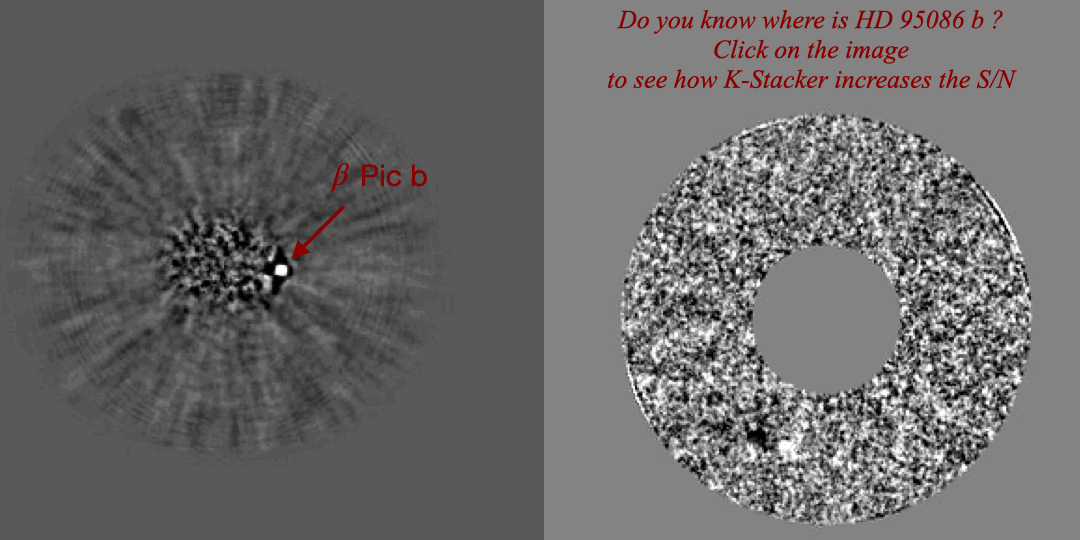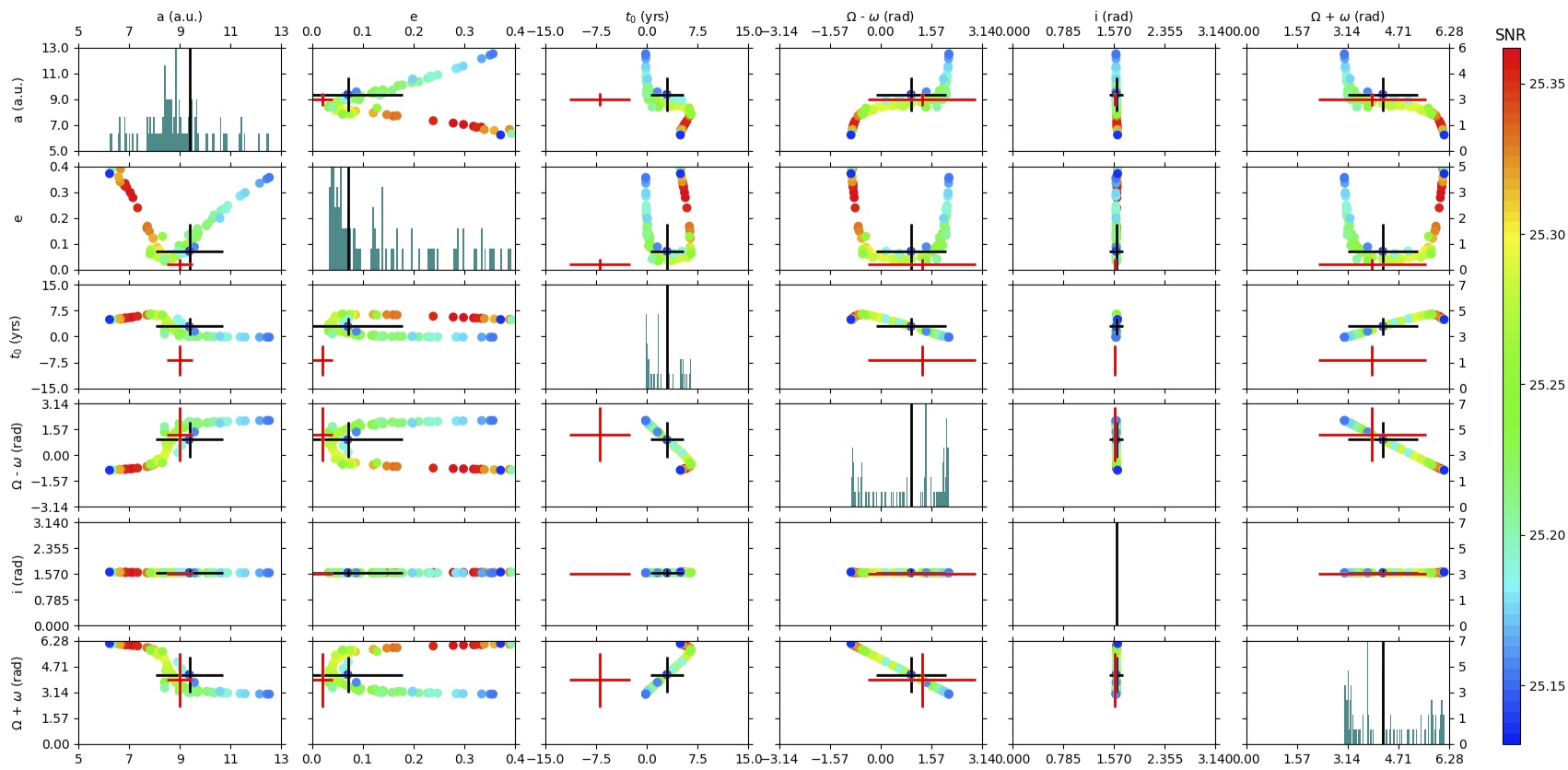K-Stacker, an algorithm to hack the orbital parameters of planets hidden in high-contrast imaging and to increase the contrast level up to a factor 10
H. Le Coroller (Aix Marseille Univ., LAM), M. Nowak (University of Cambridge, Institute of Astronomy), P. Delorme (Univ. Grenoble-Alpes, IPAG), G. Chauvin (Univ. Grenoble-Alpes, IPAG), R. Gratton (INAF-Osservatorio Astronomico di Padova), H. Beust (Univ. Grenoble-Alpes, IPAG), C. Desgrange (Univ. Grenoble-Alpes, IPAG), L.-X. Lefranc (Aix Marseille Univ., LAM), M. Devinat (Aix Marseille Univ., LAM), J. Bec-Canet (Aix Marseille Univ., LAM), et al.
Abstract
K-stacker is an algorithm
that consists in combining high contrast images recorded
during different nights, accounting for the orbital motion
of the putative planet that we are looking for. Even if an
individual image does not reveal the planet, we have shown
that K-Stacker 'brute-force algorithm' can be used to
properly align the images according to Keplerian motion and
allow for the detection of planets otherwise unreachable. In
this work, we tested K-Stacker for the first time on
real data of the main SPHERE GTO SHINE survey.
Introduction
Most of the 4100 exoplanets detected to date have been found using indirect methods. However, thanks to a combination of eXtreme Adaptive Optics (ExAO), innovative coronagraphs, differential imaging, direct imaging instruments have been able to detect and characterize several young giant planets (HR 8799 bcde, β Pictoris b, HD 95086 b, 51 Eri b, HIP 65426 b, PDS 70 b, etc.) at large separation (>∼10 au). An important finding from these high-contrast imaging surveys (GPIES, SHINE) in the past years has been the low occurrence rate of giant planets beyond 10 au (Nielsen et al. 2019; Vigan et al. 2020, accepted). A prime goal of the future surveys will be to bridge the gap with indirect techniques by imaging young Jupiters down to the snowline at about 3-5 au. To detect the core of the Jupiter-mass planets population at ≈ 3 au (i.e. ≈ 10−6 at ≈ 60 mas) 10−100 hours of exposure time will be required with futur instruments (ex: SPHERE+, ELTs instruments). Taking into account observing constraints and weather statistics, the observations will be spread over several tens of days, and the orbital motion of the potential planets will have to be taken into account before co-adding the exposures taken at several epochs. In this work, we have tested for the first time the K-Stacker algorithm performances on real SPHERE (IRDIS and IFS sub-systems) observations.
K-Stacker blind test
K-Stacker is an optimization algorithm (brute-force + gradient) that maximize the signal to noise by re-centering the images according to keplerian motions (Le Coroller et al. 2015, Nowak et al. 2018). This method can be used in combination with any high contrast reduction method (ex: PCA-ASDI technics) to improve the global detection limit and detect planets otherwise unreachable. To test K-Stacker in real condition, we have injected fake planets on random orbits in a series of raw observations obtained by the SPHERE / IRDIS instrument in the course of the SHINE survey (Chauvin et al. 2017, Beuzit et al. 2019). Before running K-Stacker each observation has been reduced by a PCA ADI algorithm of the SPHERE Data Center (Delorme et al. 2017; Galicher et al. 2018).

Figure 1: Distribution of the planet candidates found and missed as a function of the (S/N)KS.
This blind experiment showed that the success rate of K-Stacker is close to 100 % when the K-Stacker signal to noise (S/N)KS reach 9 (S/N ≈ 2 in each individual observation of our experiment); it drops significantly at (S/N)KS ≈ 5 (see Fig. 1).
Applying K-Stacker to known exoplanets
We used data on two targets repeatedly observed during the SHINE survey (β Pic, observed 11 times and HD 95086, observed 7 times). K-Stacker algorithm was good at recovering the known companions β Pic b and HD 95086 b with an optimal gain of signal to noise (see Fig. 2).

Figure 2: Recombined image resulting from the K-Stacker run on β Pictoris (left) and HD 95086 (right). K-Stacker looked blindly for the planets (without any informations on the orbital parameters). The planets b are detected with an optimal signal to noise gain in root square of the total exposure time, passing respectivelly from a S/N mean at each epoch of 7.5 to (S/N)KS = 25 for β Pictoris b and 3.6 to (S/N)KS = 9.5 for HD95086 b. The point at the south-west of HD 95086 images is an artifact (AO waffles not removed). HD 95086 b is at the limit of detectability by concidering only one observation (click on the image to see how K-Stacker increase the S/N when the number of epochs increase. Warning: It can take 1 min to load the movie).
Orbital parameters
For all the planets detected by K-Stacker in the SHINE blind test (true positives in green of Fig. 1), K-Stacker has well recovered the orbital parameters (at less than 2−σ from the parameters of injection, and at less than 0.6 pixels from the good positions in each image) although the planet has travelled over a maximum of 15−38 % of its total orbital period. For β Pic b and HD 95086 b, the orbital solutions resulting from the K-Stacker run are in good agreement with the MCMCs solutions (see exemple on β Pic at Fig. 3).
Figure 3: Corner plots of the β Pictoris b orbital parameters found by K-Stacker. The dark cross indicates the mean value of the orbital parameters with their error bars. The red cross shows the higher probability density found by a MCMC method in Lagrange et al. (2019a) converted in the K-Stacker referential.
Conclusion
We carried out a blind experiment, in which planets are injected on random orbits in the SHINE images before the PCA-ADI reduction. The K-Stacker success rate is close to 100% when the planet in the recombined ADI reduced images reach SNR_KS ≃ 8-9 (SNR ≈ 2 in individual ADI reduced images of our test). We have also re-detected two emblematic planets: β Pictoris b and HD 95086 b. The S/N gain provided by K-Stacker on these PCA-ASDI IFS images is close to optimal. We have also shown that our K-Stacker algorithm is very effective at recovering the orbital parameters (a more detailed comparison with MCMCs on the positions would be interesting when the planets are detected in individual images). This work should open a new path concerning the observing strategy used with current and future planet imagers. K-Stacker will enable future dedicated multi-epoch observation campaigns of young and nearby systems to search for low mass planets in emitted and reflected light, respectively.
More informations in : Le
Coroller, et al. 2020, A&A, accepted
References
Beuzit, J.L., Vigan, A., Mouillet, D. et
al. 2019 A&A 631, A155
Chauvin, G., Desidera, S., Lagrange, A.-M., et al. 2017a, in SF2A-2017, ed. C. Reylé, P. Di Matteo, F. Herpin, E. Lagadec, A. Lançon, Z. Meliani, &
F. Royer, 331–335
Delorme, P., Meunier, N., Albert, D., et al. 2017, in SF2A-2017: Proceedings of
60 the Annual meeting of the French Society of Astronomy and Astrophysics,
61 eds. C. Reylé, P. Di Matteo, F. Herpin, E. Lagadec, A. Lançon, Z. Meliani, &
62 F. Royer, 347
Galicher, R., Boccaletti, A., Mesa, D. et
al. 2018, A&A, 615, A92
Gratton, R., Zurlo, A., Le Coroller,
H. et al. 2020, A&A, 638, A120
Le Coroller, H., Nowak, M., Arnold, L., et al.
2015, Proceedings of colloquium 'Twenty years of giant
exoplanets' held at Observatoire de Haute Provence
Le Coroller, H., Nowak, M., Delorme, P. et al. 2020, A&A, accepted
Nielsen, E.L., De Rosa, R.J., Macintosh,
B. 2019, AJ,158, id. 13
Nowak, M., Le Coroller, H., Arnold, L. et
al. 2018, A&A 615, A144
Vigan, A., Fontanive, C., Meyer, M., et
al. 2020, A&A, accepted
